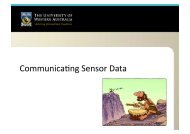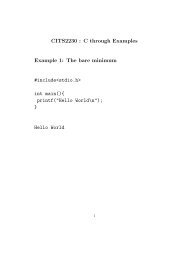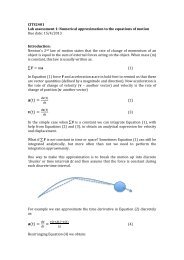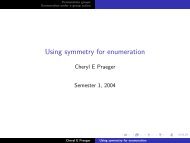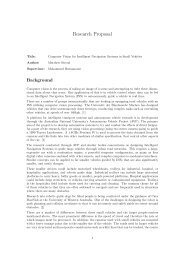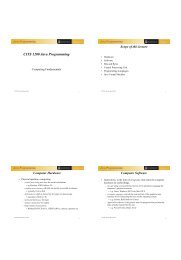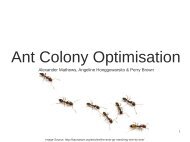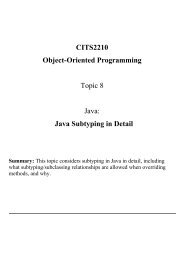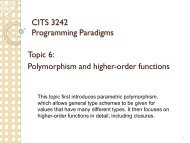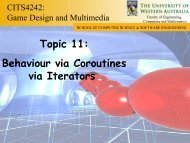CITS1200 Java Programming Multiple Choice Test ... - Undergraduate
CITS1200 Java Programming Multiple Choice Test ... - Undergraduate
CITS1200 Java Programming Multiple Choice Test ... - Undergraduate
Create successful ePaper yourself
Turn your PDF publications into a flip-book with our unique Google optimized e-Paper software.
(D) This page intentionally left blank2
1. What values do c and d respectively have after the following sequenceof statements?boolean a = true;boolean b = false;boolean c = (a || b) && !(a && b);boolean d = c || (a && b || !(a && b || (a && !b)));(a) (*)true, true(b) true, false(c) false, true(d) false, false(e) true, 02. Suppose that the class Drawer contains an instance variable sc whichrefers to a SimpleCanvas, and that it has the following method:public void mystery() {}java.awt.Color col1;col1 = new java.awt.Color(0,255,0); // Greenjava.awt.Color col2;col2 = new java.awt.Color(255,255,0); // Yellowfor (int i=0;i 100 && i < 300) {sc.setForegroundColour(col2);sc.drawLine(0,i,400,i);}5
If you call this method when the SimpleCanvas sc is blank, visibleand has size 400 × 400, then what will appear on the screen?(a) A yellow square centred in a green background.(b) A green square centred in a yellow background.(c) A thick green stripe going top to bottom on a yellow background.(d) (*)A thick yellow stripe going left-to-right on a green background.(e) A blue square centred in a yellow background.3. What is the value of the following expression?100 % 24 / 3(a) 1.3333333333333333(b) 0(c) 2(d) Evaluation causes an ArithmeticException: Division by Zero(e) (*)14. Consider the following sequence of statements where BankAccount isas given in the lectures.BankAccount b1 = new BankAccount("Bill Gates", 12345, 0);BankAccount b2 = new BankAccount("Bill Gates", 12345, 0);BankAccount b3 = new BankAccount("Larry Ellison", 54321, 0);b1.deposit(200);b3 = b2;b2.deposit(350);b3.withdraw(150);What are the values ofb1 == b2andb1.getBalance() == b3.getBalance()6
espectively?(a) true and true(b) false and false(c) true and false(d) (*)false and true(e) false and 200.5. If a and b are variables of type boolean then which of the followingexressions is true when exactly one of a and b is true, and falseunder all other circumstances?(a) a || b(b) a && b(c) (a && !b) && (!a && b)(d) (*)(a || b) && (!a || !b)(e) (a || b) || (!a || !b)6. Which of the following methods will correctly calculate the maximumvalue in an array? All of these methods compile correctly, so youare only looking for logic errors, not syntax errors. (The methodMath.max() is a library method from the <strong>Java</strong> API and returns themaximum of its two arguments.)public int max1(int[] a) {int maxPos = 0;for (int i=1; i a[maxPos]) {maxPos = i;}}return a[maxPos];}public int max2(int[] a) {int max = 0;for (int i=0; i max) {7
max = a[i];}}return max;}public int max3(int[] a) {for (int i=1; i
(b) cannot create the object b because it is already null.(c) (*)creates space for the BankAccount object and assigns the referencevalue to b.(d) will fail to compile because a ; is not expected in this statement.(e) cause a run-time error because the object b has already beendeclared.9. You are writing a program to keep track of your audio CD collection,and are defining a class CD to represent a single compact disc. You aredefining instance variables to store the title, number of tracks and costof each CD.What are the most appropriate types for those variables (in that order)?(a) String, double, String(b) char, int, int(c) (*)String, int, double(d) String, int, long(e) boolean, String, String10. What will the method call mystery(958) return, if the method isdefined as follows:public int mystery(int n) {}int m = 0;while (n > 0) {m = 10*m + n%10;n = n/10;}return m;(a) 0(b) .9589
(c) 9(d) (*)859(e) 95811. What does the method call fib(7) return if fib is defined as follows?public int fib(int n) {}int[] a = new int[n];a[0] = 1;a[1] = 1;for (int i=2; i
(e) 1 only13. What is the value of the expression10 + 5 * 4 / 3 - 13 % 3(a) 12.66666666667(b) 15.66666666667(c) 12(d) 16(e) (*)1514. What are the respective values of the following two expressions?4.0 * 7 / 24.0 * (7 / 2)(a) 14.0 and 6.0(b) 14.0 and 14.0(c) (*)14.0 and 12.0(d) 12.0 and 14.0(e) 12.0 and 12.015. Consider the following class with a single methodpublic class Doubler {public void doubleIt(int n) {n = 2*n;}}What happens when the class is compiled, and the following sequenceof statements (which is in a method of another class) is compiled andexecuted?int x = 20;Doubler d = new Doubler();d.doubleIt(x);System.out.println(x);11
(a) The code for Doubler will not compile because there is no instancevariable called n.(b) The value 40 will be printed out on the terminal window.(c) (*)The value 20 will be printed out on the terminal window.(d) The code for Doubler will not compile, because the class has noconstructors.(e) The code for Doubler will not compile because a parameter variableis read-only and cannot be assigned a value.16. What is the output of loop(8), where loop is defined as follows?public void loop(int n) {}for (int i=0; i
(d) We cannot tell because it depends on internal details of the arraysthat the client cannot access.(e) false because numerical round-off error means that the floatingpoint numbers cannot be stored exactly.18. Given the following method (you may assume it has all compiled correctlyso there are no syntax errors), what will be output?public void printloop(){int i;for (i=1; i
Method 2public int alternatingSum(int[] a) {int sum = 0;for (int i=0; i
(b) int feet = h%12;int inches = h;(c) double feet = h/12;int inches = h%12;(d) (*)int feet = h/12;int inches = h%12;(e) int feet = h-12;int inches = h/12;15



